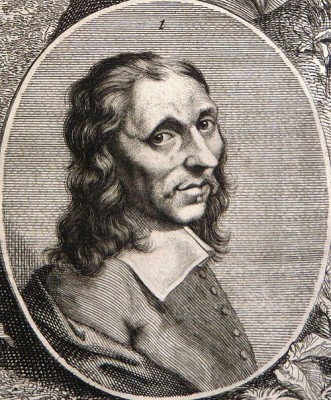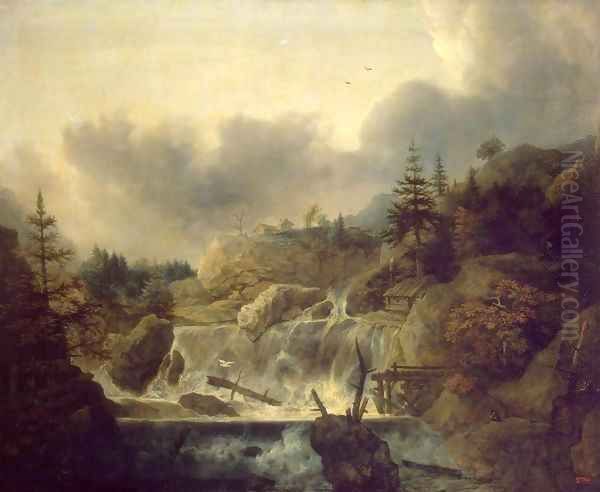
Allaert van Everdingen stands as a significant figure in the Dutch Golden Age of painting, celebrated primarily for his evocative and pioneering depictions of Scandinavian landscapes. Born on June 18, 1621, and passing away on November 8, 1675, Everdingen was not only a prolific painter but also a skilled printmaker, leaving behind a body of work that significantly influenced his contemporaries and subsequent generations of artists. His unique focus on the rugged, untamed beauty of the North set him apart in the bustling art scene of the 17th-century Netherlands.
Early Life and Artistic Formation
Allaert van Everdingen was born in Alkmaar, a town in the Netherlands. His family background provided a certain degree of social standing; his father served as a government clerk, and his brothers, Caesar van Everdingen and Jan van Everdingen, pursued careers related to law and art. This environment likely fostered his artistic inclinations from a young age. Caesar van Everdingen himself became a notable painter, known for his historical and portrait works, providing Allaert with a direct connection to the artistic world within his own family.
His formal artistic training began in Utrecht, where he studied under Roelant Savery (c. 1576–1639). Savery was renowned for his detailed landscapes, often featuring exotic animals and Alpine scenery, drawing from his own travels. Savery's influence is discernible in Everdingen's early works, particularly in the approach to rendering natural details and perhaps instilling an interest in depicting foreign terrains. Savery's own style, characterized by meticulous detail and sometimes fantastical elements, provided a foundation upon which Everdingen would build his distinct artistic identity.

Following his time in Utrecht, Everdingen moved to Haarlem to further hone his skills under the tutelage of Pieter Molyn (1595–1661). Molyn was a leading figure among the Haarlem landscape painters, known for his more tonal and atmospheric depictions of the Dutch countryside, often featuring dunes and rural scenes executed with a relatively free brushstroke. Studying with Molyn exposed Everdingen to different stylistic approaches to landscape painting, emphasizing atmosphere and a more naturalistic representation of light and terrain, which complemented the detailed style he might have absorbed from Savery. Some sources suggest potential early inspiration from the master Rembrandt van Rijn, particularly regarding the dramatic use of light and shadow (chiaroscuro) and color application, elements that would become characteristic of Everdingen's mature style.
The Transformative Scandinavian Journey
A pivotal moment in Allaert van Everdingen's life and artistic development was his journey to Scandinavia, undertaken around 1644. While the exact circumstances prompting the trip are debated (some accounts suggest shipwreck), its impact is undeniable. He traveled through parts of Norway and Sweden, visiting areas possibly including the regions around Uppsala and Gothenburg in Sweden, and perhaps coastal areas like Risør in Norway. This exposure to the dramatic, untamed landscapes of the North – vastly different from the flat terrain of the Netherlands – profoundly shaped his artistic vision.
The experience provided him with a wealth of new subject matter: towering mountains, cascading waterfalls, dense pine forests, rustic wooden cabins, and dramatic rocky coastlines. These elements became the hallmarks of his most famous works. He meticulously sketched the scenery during his travels, and these studies served as the basis for numerous paintings and prints created throughout the rest of his career. This journey effectively allowed Everdingen to carve out a unique niche within Dutch landscape painting, introducing the exoticism and grandeur of the Nordic wilderness to a Dutch audience.
His depictions of Scandinavia were not merely topographical records; they were imbued with a sense of drama, wildness, and sometimes melancholy. He captured the power of nature, often contrasting the imposing scale of mountains and waterfalls with small human figures or structures, emphasizing nature's dominance. This focus on the sublime aspects of the natural world was innovative for its time in Dutch art and resonated strongly with collectors.
Artistic Style and Techniques
Allaert van Everdingen developed a distinctive artistic style characterized by several key features. His paintings often exhibit rich color palettes and strong contrasts between light and shadow, creating a sense of depth and drama. His compositions are carefully constructed, often employing diagonal lines formed by rivers, rocks, or fallen trees to lead the viewer's eye into the scene. He possessed a remarkable ability to render the textures of nature – the rough surfaces of rocks, the turbulent flow of water, the feathery foliage of pine trees – with convincing detail.
His style stands apart from those of his teachers, Roelant Savery and Pieter Molyn. While he may have inherited Savery's interest in detail and exotic subjects, Everdingen's work generally possesses a greater sense of atmospheric unity and dynamism than Savery's often more static compositions. Compared to Molyn's typically Dutch scenes, Everdingen's landscapes are far more dramatic and imbued with a sense of the wild and untamed, reflecting his Scandinavian inspiration. His works often convey a mood that is both majestic and slightly mysterious.
Beyond painting, Everdingen was a master printmaker, particularly skilled in etching and possibly experimenting with mezzotint techniques to achieve rich tonal effects. He produced over 150 etchings, many of which revisit his favored Scandinavian themes. His prints are noted for their technical proficiency, lively lines, and effective use of light and shadow to create atmosphere and volume. He was among the earliest artists to extensively use etching for landscape subjects, demonstrating innovation in the medium. His prints allowed his unique vision of the Nordic landscape to reach a wider audience.
Major Works and Themes
Allaert van Everdingen's oeuvre is dominated by his Scandinavian landscapes. These works cemented his reputation and remain his most celebrated contribution to art history. A representative example is often generically titled Scandinavian Landscape, encompassing numerous paintings that feature his characteristic motifs: powerful waterfalls crashing over rocks, dark forests of pine and birch, rustic log cabins, and towering cliffs under dramatic skies. These paintings capture the essence of the Nordic wilderness as perceived through his Dutch sensibility, emphasizing its ruggedness and grandeur.
Another significant work is Hendrik Trip’s Cannon Foundry in Julitabruk, Sweden. This painting is notable for depicting an industrial scene within a natural landscape setting, showcasing a different facet of his Scandinavian experience. It combines his skill in landscape representation with an observation of human activity, specifically the burgeoning industry supported by Sweden's natural resources. This work provides valuable insight into 17th-century industrial processes and the economic connections between the Netherlands and Sweden.
Everdingen also demonstrated his versatility and narrative skill in his series of illustrations for the fable Reynard the Fox. This project resulted in 57 etchings, showcasing his ability to depict animals with character and humor, embedding them within detailed landscape settings. The series was highly popular and demonstrated his engagement with literary themes, exploring the allegorical potential of animal behavior within the natural world. These prints further highlight his mastery of the etching medium and his imaginative capabilities. While primarily known for landscapes, his early career also included seascapes, likely influenced by marine specialists like Adam Willaerts and perhaps Jan Porcellis, whose works he might have encountered.
Career, Recognition, and Activities as a Collector
After his formative years and travels, Everdingen's career progressed steadily. He spent time in Haarlem, where he continued his studies with Pieter Molyn. By 1645, he was documented in Haarlem, where he married Janneke Cornelisdr. Brouwers on February 21st of that year. During this period, he also became a member of the Reformed Church. His presence in Haarlem placed him within one of the key centers of Dutch landscape painting.
In 1652, Everdingen relocated to Amsterdam, the vibrant commercial and cultural heart of the Dutch Republic. This move proved advantageous for his career. His unique Scandinavian landscapes found a receptive audience among the wealthy merchants and collectors of the city. His works became highly sought after, commanding significant prices in the competitive Amsterdam art market. He established himself as one of the successful and popular painters of his time, particularly noted for his specialized subject matter.
Beyond his activities as a painter and printmaker, Allaert van Everdingen was also active as an art dealer and collector. His personal collection, inventoried after his death, reveals a discerning eye and broad taste. It included works attributed to major Italian Renaissance masters like Raphael and Titian, Venetian painters such as Veronese, the German master Hans Holbein the Younger, and prominent Dutch and Flemish artists including Rembrandt, Frans Hals, Joachim Beuckelaer, Jan Porcellis, and the German-born painter active in Italy, Johann Liss. This activity indicates his deep engagement with the art world, both past and present, and suggests a sophisticated understanding of art history and market value. His collection itself was a notable asset, eventually sold as part of his estate.
Influence and Lasting Legacy
Allaert van Everdingen's introduction of Scandinavian themes into Dutch art had a profound and lasting impact. His dramatic depictions of waterfalls, rocky gorges, and pine forests offered a striking alternative to the more common Dutch pastoral landscapes. His work significantly influenced one of the greatest Dutch landscape painters of the era, Jacob van Ruisdael. Ruisdael adopted similar motifs, particularly waterfalls and Nordic-inspired scenery, integrating Everdingen's innovations into his own powerful and melancholic vision of nature. The influence is so marked that distinguishing between the works of the two artists, particularly their waterfall scenes, can sometimes be challenging for non-specialists.
Everdingen's influence extended beyond his immediate contemporaries. His dramatic and often sublime representations of nature can be seen as prefiguring some of the sensibilities that would later characterize the Romantic movement in the late 18th and 19th centuries, with its emphasis on the power, wildness, and emotional impact of the natural world. While a direct link to later movements like French Impressionism mentioned in some secondary analyses might be tenuous, his focus on capturing the effects of light and atmosphere in rugged terrains certainly contributed to the evolving tradition of landscape painting.
His legacy was also carried on directly through students, such as Gerard Edema, who reportedly adopted his master's style and later worked in England, helping to disseminate a taste for dramatic landscape painting abroad. Everdingen's numerous etchings also played a crucial role in spreading his artistic ideas and imagery.
Conclusion
Allaert van Everdingen died in Amsterdam on November 8, 1675, at the age of 54. He left behind a significant body of work that distinguishes him as a key innovator within the Dutch Golden Age. Through his paintings and prints, he introduced the dramatic beauty of the Scandinavian wilderness to a wide audience, enriching the tradition of Dutch landscape art with new themes and a heightened sense of natural drama. His technical skill, both as a painter and an etcher, combined with his unique experiences and artistic vision, secured his place in art history. As a teacher, collector, and influential figure, his impact resonated through the works of artists like Jacob van Ruisdael and contributed to the broader evolution of landscape painting in Europe. Allaert van Everdingen remains celebrated for bringing the wild heart of the North into the homes and galleries of the Dutch Republic.